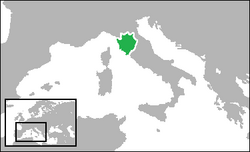فلورنس جي جمهوريا
فلورنس جي جمهوريا (Republic of Florence؛ لاطيني: Res publica Florentina؛ اطالوي: Repubblica di Firenze)، سرڪاري طور تي فلورينس ريپبلڪ (اطالوي: Repubblica Fiorentina) جي نالي سان سڃاتي وڃي ٿي، هڪ قرون وسطي ۽ ابتدائي جديد رياست هئي، جيڪا اٽلي جي علائقي، ٽسڪاني ۾ اطالوي شهر، فلورنس جي مرڪز تي هئي.[1] جمهوريا سال 1115ع ۾ شروع ٿي، جڏهن فلورنس جي ماڻهن ٽسڪاني جي ماٽيلڊا جي موت تي ٽسڪاني جي مارگرويئيٽ خلاف بغاوت ڪئي، جنهن فلورنس سميت وسيع علائقن تي ڪنٽرول ڪيو. فلورنٽائنس جانشين جي جاءِ تي هڪ ڪميونٽي ٺاهيا.[2] جمهوريا ۾ هڪ ڪائونسل جي حڪمراني هئي جيڪا فلورنس جي سائنوريا جي نالي سان مشهور هئي. سائنوريا (Signoria) گونفالونيئر (شهر جو ٽائيٽل حڪمران) طرفان چونڊي ويندي هئي، جيڪو فلورنٽائن گلڊ جي ميمبرن طرفان هر ٻن مهينن ۾ چونڊيو ويندو هو.
Republic of Florence | |||||
|---|---|---|---|---|---|
| 1115–1569 | |||||
| |||||
 | |||||
| گادي جو هنڌ | Florence 43°46′10″N 11°15′22″E / 43.76944°N 11.25611°E | ||||
| مذهب | Roman Catholicism | ||||
| مقامي آبادي | Florentine | ||||
| حڪومت | Oligarchic Republic (1115–1494; 1498–1532) Republic under a theocratic regime (1494–98) | ||||
| مقننه | Priorato delle Arti | ||||
جمهوريه جي تاريخ دوران، فلورنس يورپ ۾ هڪ اهم ثقافتي، اقتصادي، سياسي ۽ فنڪشنل قوت هئي. ان جو سڪو، فلورين، مغربي يورپ جو وڏي پيماني تي واپار لاءِ غالب واپاري سڪو هو ۽ سڄي براعظم ۾ وڏي پيماني تي نقل ٿيو. ريپبلڪن دور ۾، فلورنس پڻ ريناسنس جي جنم ڀومي هئي، جنهن کي يورپي ثقافتي، فني، سياسي ۽ اقتصادي "ٻيهر جنم" جو هڪ پرجوش دور سمجهيو ويندو آهي.
جمهوريه ۾ مختلف گروهن جي خلاف بغاوتن ۽ جوابي بغاوتن جي تاريخ هئي. ميڊيسي گروپ سال 1434ع ۾ ڪوسيمو ڊي ميڊيسي جي ماتحت شهر جي حڪومت حاصل ڪئي. ميڊيسي 1494ع تائين فلورنس تي ڪنٽرول رکيو. جيوواني ڊي ميڊيسي، جيڪو بعد ۾ پوپ ليو ڏهين ٿيو، سال 1512ع ۾ جمهوريا ٻيهر فتح ڪيو. فلورنس سال 1527ع ۾، ليگ آف ڪانگيڪ جي جنگ دوران، ٻي دفعي ميڊيسي اختيار کي رد ڪري ڇڏيو. ميڊيسي، شهنشاهه چارلس پنجون جي مدد سان، شهر جي 11 مهينن جي گهيري کان پوءِ سال 1531ع ۾ پنهنجي حڪومت ٻيهر شروع ڪئي. پوپ ڪليمينٽ ستون، جيڪو پاڻ هڪ ميڊيسي هو، جمهوريت کي موروثي بادشاهت ۾ تبديل ڪرڻ، پنهنجي مائٽ، اليسندرو ڊي ميڊيسي کي پهريون ”ڊيوڪ آف دي فلورنٽائن ريپبلڪ“ مقرر ڪيو.
ٻيو ڊيوڪ، ڪوسيمو پهريون، هڪ مضبوط فلورنٽائن نيوي قائم ڪئي ۽ پنهنجي علائقي کي وڌايو، سائنا کي فتح ڪيو. 1569ع ۾ پوپ ڪوسيمو کي ٽسڪاني جو پهريون گرانڊ ڊيوڪ قرار ڏنو. ميڊيسي 1737ع تائين ٽسڪاني جي گرانڊ ڊچي تي حڪومت ڪئي.
During the Republic's history, Florence was an important cultural, economic, political and artistic force in Europe. Its coin, the florin, was the dominant trade coin of Western Europe for large scale transactions and became widely imitated throughout the continent.[3][4] During the Republican period, Florence was also the birthplace of the Renaissance, which is considered a fervent period of European cultural, artistic, political and economic "rebirth".[5]
The republic had a checkered history of coups and countercoups against various factions. The Medici faction gained governance of the city in 1434 under Cosimo de' Medici. The Medici kept control of Florence until 1494. Giovanni de' Medici, who later became Pope Leo X, reconquered the republic in 1512.
Florence repudiated Medici authority for a second time in 1527, during the War of the League of Cognac. The Medici reassumed their rule in 1531 after an 11-month siege of the city, aided by Emperor Charles V.[6] Pope Clement VII, himself a Medici, appointed his relative Alessandro de' Medici as the first "Duke of the Florentine Republic", thereby transforming the Republic into a hereditary monarchy.[6][7]
The second duke, Cosimo I, established a strong Florentine navy and expanded his territory, conquering Siena. In 1569, the pope declared Cosimo the first grand duke of Tuscany. The Medici ruled the Grand Duchy of Tuscany until 1737.
- ↑ Brucker, Gene A. (1998). Florence: The Golden Age 1138–1737. University of California Press. ISBN 0-520-21522-2. https://archive.org/details/florencegoldenag00bruc_0.
- ↑ "History of Florence". Aboutflorence.com. وقت 1 August 2020 تي اصل کان آرڪائيو ٿيل. حاصل ڪيل 2009-05-26. Unknown parameter
|url-status=ignored (مدد) - ↑ "Florence – Climate". Encyclopædia Britannica. وقت 17 April 2015 تي اصل کان آرڪائيو ٿيل. حاصل ڪيل 2021-10-19. Unknown parameter
|url-status=ignored (مدد) - ↑ "Fiorino". حاصل ڪيل 2023-03-15.
- ↑ "Renaissance". History.com. وقت 19 October 2021 تي اصل کان آرڪائيو ٿيل. حاصل ڪيل 2021-10-19. Unknown parameter
|url-status=ignored (مدد) - ↑ 6.0 6.1 Goudriaan (2018), pp. 8–9.
- ↑ Strathern (2007), p. 321.



